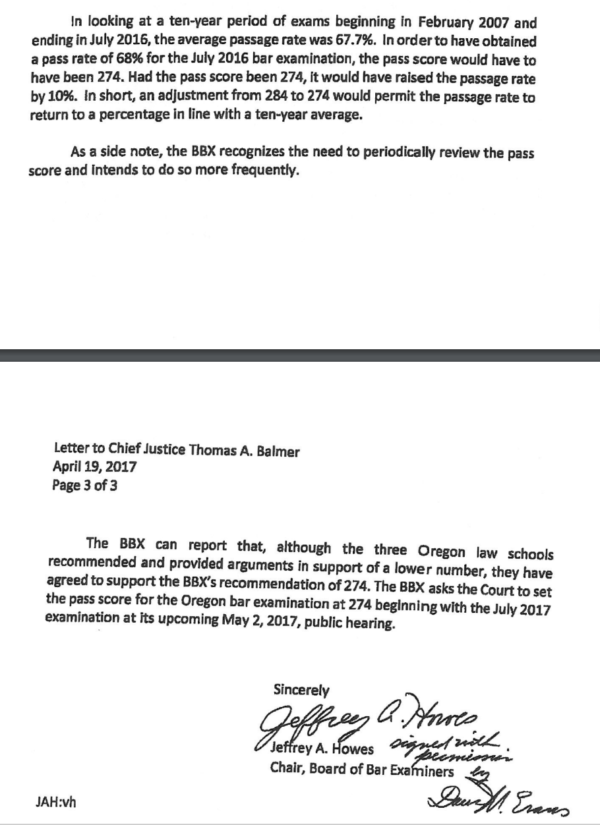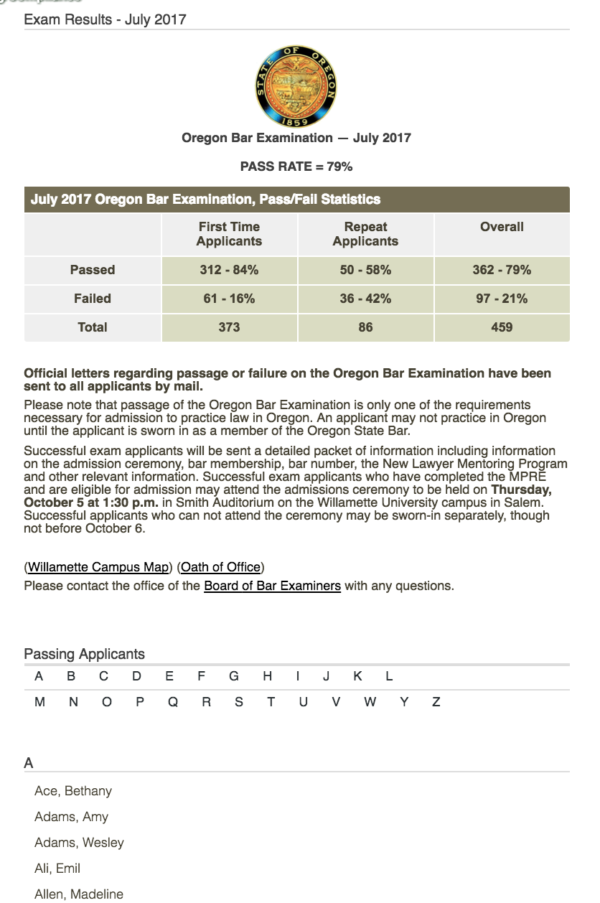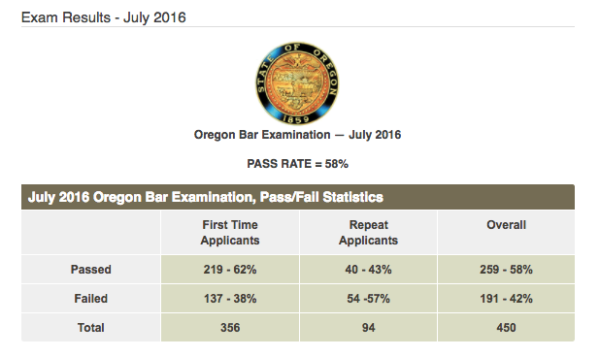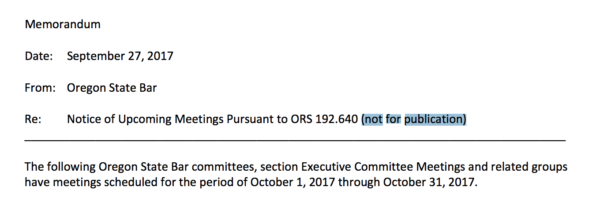9/27/2017 with 10/4 update:
Normally about 260 people pass the July Oregon Bar exam. This spring the Oregon Supreme Court dumbed down the pass score and made some other changes, and 360 people passed. Obviously this is good news for the 100 students who otherwise wouldn’t be licensed to practice law, and good news for the Oregon Bar, which collects an annual $470 from each. It’s bad news for those 260 students who would have passed the older, harder exam, and who now have to try and find a job in an even more flooded job market.
Oregon’s pass rate for the July exam, (all takers, not just UO students) has jumped from 58% last year to 79% this year. That’s a 21 percentage point increase or a (79-58)/58=36% increase in the success odds, in one year. In July 2016 the average pass rate for all US takers was 62%, compared to 58% for Oregon. So we were a little low, but not by much.
In July 2016, only Nebraska had a higher percentage of takers (82%) passing than Oregon’s 2017 new rate of 79%. (Kansas and Missouri were tied at 79%, Oregon’s new rate). See http://www.ncbex.org/pdfviewer/?file=%2Fdmsdocument%2F205 So, with one decision made without adequate prior public notice or discussion, and apparently with no discussion in the Oregon Supreme Court, Oregon has gone from being middle of the road to being among the four easiest states in which to get a license to practice law.
This is not what the Oregon Board of Bar Examiners intended. According to internal documents obtained with a public records request, the BBX believed these changes would increase the pass rate to about 68%. They explicitly rejected a proposal from the three deans of Oregon’s law schools for an even lower cut-score, apparently because they thought that would produce a pass rate of 78%, which they thought was too high. I wonder if the deans will now argue for raising the cut-score and lowering the pass rate?

(From the April 19 letter from BBX chair Jeffrey Howes to Oregon Chief SC Justice Thomas Balmer, at https://uomatters.com/wp-content/uploads/2017/08/Official-letters-to-Court-BBX-PubRcrdsReq-Aug-17.pdf)
In short Oregon’s new test, with the new lower cut-score, is much easier to pass than the old one, and much easier than the BBX led the Supreme Court to believe. It has given Oregon what is almost the highest pass rate in the country.
It’s true that the new exam will also make it easier for Oregon law students to move to other states, assuming their score was high enough to have passed those state’s cut-rate. But why is Oregon subsidizing the tuition of out-of-state students who will take out-of state legal jobs – if they can even find them?

For comparison, last July:

Michael Tobin has a brief report about this in the Daily Emerald, here.
10/4/2017 NOTE: I’ve now received two letters from the Oregon Bar, arguing that they did not break the public meetings law, while also promising that they will now post meeting notices on the bar’s website. As you can see from their October posting, they’re still trying to figure this transparency thing out:

…
I’ve got some more public records requests into them and the Oregon Supreme Court (which has updated its website and fixed some of its public records procedures in response to my previous questions to them) and I will post what I find out.
Posted 9/27/2017 and earlier:
As noted, the Oregon Bar Board of Examiners and Oregon Supreme Court thought that the decrease in the cut score would only increase the pass score to 68%. Or at least that’s what I think they thought – it’s still not clear if the Court and the Bar followed state law in their meetings on this. Here’s another attempt to find out:
Hi Kateri –
I’d like to make two additional public records requests:
1) Any documents showing that the March 20th meeting of the BBX was announced with public notice, as required by ORS 192.
2) Copies of the agendas and minutes and public meetings notices for the BBX subcommittee charged with making recommendations to the BBX on the pass score, as required by ORS 192.
I ask for a fee waiver on the basis of public interest.
Thanks, Bill Harbaugh
As for the Oregon Supreme Court, they still seem to be in some sort of denial about their legal obligations under ORS 192:
Hi Tim –
I was looking through the ORS, and it looks like the Supreme Court is bound by the usual rules for public meetings: 192.650 Recording or written minutes required; content; fees. (1) The governing body of a public body shall provide for the sound, video or digital recording or the taking of written minutes of all its meetings. Neither a full transcript nor a full recording of the meeting is required, except as otherwise provided by law, but the written minutes or recording must give a true reflection of the matters discussed at the meeting and the views of the participants. All minutes or recordings shall be available to the public within a reasonable time after the meeting, and shall include at least the following information:
(a) All members of the governing body present;
(b) All motions, proposals, resolutions, orders, ordinances and measures proposed and their disposition;
(c) The results of all votes and, except for public bodies consisting of more than 25 members unless requested by a member of that body, the vote of each member by name;
(d) The substance of any discussion on any matter; and
(e) Subject to ORS 192.410 to 192.505 relating to public records, a reference to any document discussed at the meeting.
So they want dumbed down standards so they can pass the bar exam, thinking this will allow them to pay off their stupendous student loans. But this will just flood an already overcrowded market with yet more underqualified and in any case unemployable lawyers. Not going to have a happy end.
Kind of like grade inflation at the universities.
A lose lose situation for everyone
This situation is nothing like grade inflation. The contention about grade inflation is that it supposedly makes it difficult to determine who the “good” students are. Not even the crankiest complainer about grade inflation thinks that incompetent students are being passed.
As Bar Examiner below notes, the cut point for a professional exam is supposed to indicate the threshold for professional competence. It’s not supposed to artificially limit the number of licenses to match the number of available jobs.
oh I am quite a cranky complainer and I think incompetent students
are passed all of the time. I know I certainly pass them …
Maybe you’re passing students who should fail, but the data says that about the same percentage of students have gotten Fs for the past 50 years.
https://economix.blogs.nytimes.com/2011/07/14/the-history-of-college-grade-inflation/?_r=0
check the percentage of students that have gotten F’s at the UO …
Let’s just say that the Gentleman’s C, as was once bemusedly spoken of, ain’t what it used to be. More like the Gentleman’s B now. Or at some of them fancy pants places, the Gentleman’s A-. Except, of course, we no longer speak of the students as Ladies and Gentlemen. Hah!
Until the Supreme Court acted, Oregon had the third highest “cut score” of any US jurisdiction, at 284. Most states set the cut score at 270. California (one of only two states with a higher cut score) is in the process of lowering its cut score and New York’s cut score is only 266. Why does Oregon have such a high cut score? Is that score necessary to separate those who can competently practice law from those who cannot?
Nothing of which I am aware suggests that the former 284 cut score was determined in a psychometrically valid fashion to distinguish competent from incompetent lawyers. Thus, to hold on to the score as some sort of sacred line makes little sense. Instead, Oregon should be able to justify its position as an outlier among the states. It cannot.
I was a member of the 2008 Oregon State Bar Admissions Task Force. We recommended that the Supreme Court, in consultation with the Board of Bar Examiners and other interested groups, commission a standard-setting study to determine the
appropriate cut score for the MBE in Oregon. Although it has taken ten years, I am pleased that the question of what a valid cut score should be was finally adressed by the Oregon Supreme Court.
Thanks for this informative comment.
I will post the arguments that the Supreme Court used in making its decision, when and if I get them.
Bar passage has no correlation to how good a lawyer will be. There are a ton of bad lawyers who passed the exam, and there are a ton of people who didn’t pass, but would make great attorneys.
If true, it is beyond disappointing that Oregon law students helped push to water down the exam standards. I’m old enough that the plummeting value of my UO law degree isn’t going to affect my career, but I feel bad for the young ‘uns who are soon going to have to put their degrees to use.
GG, you get it, nuff said.
The letter from the deans is deceptive and this plan is poorly conceived. At UO Law 83% of students pass the bar the first time. (Better than Willamette or L&C, but they are also good). The problem is they can’t find jobs. Ten months after graduation, only 60% of UO law graduates are employed in jobs using their J.D. And now they’re going to have to compete with a flood of new lawyers. What a dumb idea, Dean Moffitt and AD Commissiong. Lowering standards might help law schools, but it will hurt plenty of your students. Doesn’t anyone remember what motivated Margie Paris’s plan to fund jobs for unemployed grads?
Point taken, though I’m not sure where you got those numbers. The latest ABA employment data, for UO’s class of 2016, shows 52% of the 129 UO law grads have a job requiring a JD and 70% have a job using their JD. (20% are unemployed and looking, which is astounding given Oregon’s overall unemployment rate of 3.7%. http://employmentsummary.abaquestionnaire.org/
As for the Paris plan, I thought it was pretty clever but not everyone agreed. When it was proposed in 2014 the class of 2013 actually had higher employment rates than 2016 does now. http://www.oregonlive.com/business/index.ssf/2014/04/oregon_law_professor_makes_wav.html
Doesn’t the move to lower the score coincide with Oregon’s adoption of the Uniform Bar Exam? If Oregon had kept the 284 passing score it would have had the highest passing score of any UBE state. Even at 274 it is still higher than most other states.
https://en.wikipedia.org/wiki/Uniform_Bar_Examination
Thanks for continuing to push for answers re: process. For what its worth, when you look at the studies done in California, many of the panelists & researchers actually argue for a -higher- standard, and the consensus was to leave the standard where it was. Why? Because the research demonstrates that lowering the standard will lower the quality of the professional. There will be more discipline necessary for incompetence. calbar.ca.gov/cbe/docs/agendaItem/Public/agendaitem1000001929.pdf excessofdemocracy.com/blog/2017/7/more-evidence-suggests-californias-passing-bar-score-should-stay-in-place & excessofdemocracy.com/blog/2017/6/draft-work-in-progress-the-high-cost-of-lowering-the-bar Separate research on the professionals in general come to the same conclusion – there will be more ‘charlatans’. See Regulation of Charlatans in High-Skill Professions by Jonathan B. Berk, Jules H. van Binsbergen #23696 (AP CF LE LS) http://papers.nber.org/papers/W23696?utm_campaign=ntw&utm_medium=email&utm_source=ntw
As already noted, the real impetus behind this is that law schools have lowered their own standards, taking in less qualified individuals, and are worried that poorer performance threatens their own livelihoods. Just a numbers game – boost pass rates by lowering standards. Voila!
The morning’s coffee spit-take: discovering my name on the list of passing applicants on the bar exam. *buffs her fingernails*